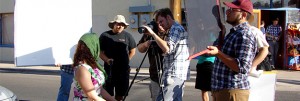Author Archives | Margaret Randall
Margaret Randall (1936) was born in New York City but grew up in Albuquerque and lived half of her adult life in Mexico, Cuba, and Nicaragua. When she returned to the U.S. in 1984 she was ordered deported under the U.S. Immigration and Nationality's McCarran-Walter Act. The government alleged that her writings, "went against the good order and happiness of the United States." She won her case in 1989.
She is a local poet who reads nationally and internationally. Among her recent books of poetry are My Town, As If The Empty Chair / Como Si La Silla Vacia, and The Rhizome As A Field of Broken Bones, all from Wings Press, San Antonio, Texas. A feminist poet's reminiscence of Che Guevara, Che On My Mind, is just out from Duke University Press, a new collection of essays, More Than Things, is out from The University of Nebraska Press, and Daughter of Lady Jaguar Shark, a single long-poem with 15 photographs, is now available from Wings. Her most recent poetry collection is About Little Charlie Lindbergh (also from Wings Press).
Randall resides in Albuquerque with her partner, the painter Barbara Byers, and travels widely to read and lecture. You can find out more about Margaret, her writings and upcoming readings at, www.margaretrandall.org.
Friday Voyage: Pie Town

Whimsy and hardscrabble life on the San Agustín Plains of New Mexico.
Continue reading...Six Degrees of Separation?
27. February 2014
Six degrees of separation has become a cliché, or at the very least a metaphor for the idea that chance and science are linked in connecting us. We are surrounded by a variety of circumstantial evidence attesting to the fact that we touch one another in ways we may find surprising. The oft-mentioned “global village,” and other versions of “togetherness” as desirable states pop up at unexpected times and in the least likely places.
Yet despite the apparent shrinkage of modern day life, we have never been more separate...
Continue reading...Friday Voyage: Grand Canyon
21. February 2014

Margaret Randall explores a palette of ever-changing light in the West's most endearing chasm.
Continue reading...Conscious Naming
18. February 2014
In Dorothea Lange: Grab a Hunk of Lightning: Her Lifetime in Photography by Elizabeth Partridge (San Francisco, Chronicle Books, 2013), I find the following paragraph: “Like many of the other San Francisco bohemians, Maynard [Dixon] and Dorothea found the label ‘artist’ highly suspect. In a kind of reverse snobbery, those who called themselves artists were thought to be more interested in being an artist than in making serious art ( . . . ) ‘I was a tradesman,’ Dorothea said. ‘I really and seriously tried, with every person I photographed, to reveal them as closely as I could.’” (p. 13)
This passage brought to mind the very different weights, different meanings even, that certain words hold for us, depending upon our cultural contexts and the time in which we live...
Continue reading...Friday Voyage: The Women’s Plaza of Honor
14. February 2014

Remembering the lives, contributions and collective history of women in a beautiful plaza at the University of Arizona.
Continue reading...The New Deal, New Mexico and Dorothea Lange
11. February 2014

WPA art at the National Hispanic Cultural Center and remembering the trailblazing photographer who captured the soul of a vulnerable nation.
Continue reading...Friday Voyage: Chloride
07. February 2014

Nearly frozen in time, a ghost town with 13 inhabitants preserves its past while fostering a budding community.
Continue reading...Friday Voyage: El Salvador
30. January 2014

In a country battered by decades of violence and instability, a New Mexican organization is supporting community resilience through economic and environmental sustainability.
Continue reading...Filmmaking New Mexico: The Non-Hollywood Projects
24. January 2014

Margaret Randall on New Mexico film history, state incentives and a new independent production.
Continue reading...Friday Voyage: Ojo Caliente
16. January 2014

Margaret Randall explores the realities and facades of ancient, healing hot springs in Northern New Mexico.
Continue reading...


28. February 2014
2 Comment